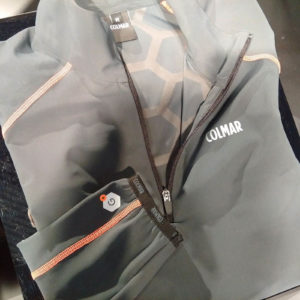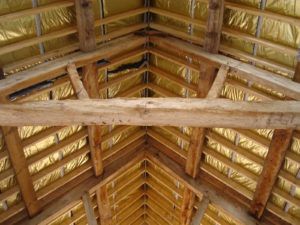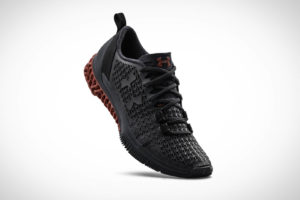
Nonelectronic fabrics can cool, warm and clean themselves—and enhance the health and performance of the wearer.
Much attention has been given to textiles that are integrated with electronic sensors and circuitry (e-textiles). But some smart textiles do not rely on electronics. According to Rebeccah Pailes-Friedman, professor and founder of the Pratt Institute Intelligent Materials Applied Research and Innovation (IMARI) Lab in Brooklyn, N.Y., and author of Smart Textiles: Inventing the Future of Fabrics, “Many smart fabrics have been developed through advanced chemistry to change their physical characteristics in different situations.”
Hotter and cooler
A range of thermo-regulating technologies for apparel has emerged since the development of phase-change materials in the 1990s, with the emphasis shifting to innovative polymers and nanotechnologies.
Coolcore™, a company based in Portsmouth, N.H., uses a cooling technology based on a combination of polymers that deliver three distinct functions when activated by moisture: wicking, moisture circulation and regulated evaporation. The patented technology is said to reduce the temperature of the fabric surface by as much as 30 percent, compared with skin temperature.
New fibers are also being developed that can convert energy into warmth, such as Hyosung Heat On™ polyester, which contains a proprietary mineral to absorb and transform solar energy into thermal energy to warm the body. From Invista, THERMOLITE® INFRARED technology utilizes the near-infrared rays of the sun or other light sources to generate heat within its hollow-fiber THERMOLITE PRO® insulation.
Some smart technologies rely on barriers or membranes for thermoregulation. A shape-memory polymer used in Thermore® Thermal Booster smart insulation firms up when the temperature drops. “The polymer is flexible at one temperature and closes off at a colder temperature, creating an additional thermal barrier,” says Joe DiGirolamo, Thermore’s U.S. sales director.
A similar principle is utilized by TLX™ Gold dynamic building insulation, from TLX Insulation Ltd., Lancashire, U.K. Combining breathable materials such as cellulose, recycled microfiber polyester wadding and microporous polypropylene, the roofing “breathes” according to the amount of moisture generated by the building’s interior, eliminating the need for a vapor barrier.
Nanomaterials such as graphene also hold potential for thermo-regulating applications. Colmar’s line of sportswear enhanced with Graphene Plus (G+) from Directa Plus S.p.A. was launched in January. “We verified through thermographic tests that the heat diffusion in samples treated with Graphene G+ is superior to that in samples not treated,” says Colmar CEO Giulio Colombo. Both companies are based in Italy.

Cleaner and safer
Bioactive or self-cleaning attributes are showing up in smart textiles for both apparel and environments. Quick-Med Technologies Inc., Gainesville, Fla., has developed a product called Oxi Fresh™ that permanently binds hydrogen peroxide (H202), a natural antimicrobial, to the textile.
According to Quick-Med founder David Lerner, Oxi Fresh reduces the need to wash textiles as frequently, or at high temperatures, conserving water and energy. Oxi Fresh maintains its efficacy for 75 home launderings, contains no harmful chemicals or nanoparticles and breaks down into water and oxygen.
To keep interiors fresh and clean, products from German company T47 Bioactive Wallcoverings GmbH contain a catalytic metal salt that converts unpleasant odors and environmental pollutants into natural and harmless substances, along with silver ions that inhibit the growth of microbes. Created with Trevira® CS, the wallcoverings are also flame-retardant and offer good acoustic properties.
Enhancing performance
The ongoing development of performance-enhancing smart materials for the active sport and outdoor markets is particularly exciting, with innovation labs at big brands such as Under Armour Inc. (UA) leading the way. UA is the first active apparel brand to use auxetic materials; when stretched, they flex and become thicker perpendicular to the force applied. Based on a series of hingelike structures, auxetic materials also absorb impact and resist fractures.

With previous forays into auxetic-inspired design in its ClutchFit compression gear and Volt sports shoe, UA has just released its 3D printed Architech hybrid trainer. An innovative 3D printed midsole is combined with a 3D printed ClutchFit auxetic upper that flexes and moves with the foot.
Open-cell polyurethane foam is another development in smart textiles for impact protection. PORON® XRD™ extreme impact protection absorbs 90 percent of the energy generated by a high-speed impact, yet is thin, light, flexible and breathable. Like a shape-memory polymer, the material is soft when at rest above the glass transition temperature of the urethane modules, but freezes on impact to form a protective shell.
“What we are trying to make happen is a revolution in impact protection that you can wear without noticing that you are wearing it,” says Dave Sherman, innovation leader for the XRD Impact Institute at Rogers Corp., Rogers, Conn.
The fitness segment is driving a textile innovation called VOXX Human Performance Technology (HPT). Jay Dhaliwal, president and CEO of VOXX Sports, Mississauga, Ont., Canada, has developed “smart” patterns that can be knit or woven into apparel textiles. When positioned to activate key neurosensors on the skin, the patterns stimulate the central nervous system to improve the wearer’s gait, posture, mobility and aerobic performance.
The drug-free, nonelectronic smart technology is applicable to all types of apparel textiles; patterns have been put into socks, insoles, compression wear and cycling gear for testing. “When people talk about performance apparel, they talk about the material,” says Dhaliwal. “VOXX HPT improves the performance of the wearer, using virtually any type of material.”
There’s more to come in nonelectronic smart textiles: self-healing polymers, superabsorbent materials, and photochromic and thermochromic colorants are among them.
Debra Cobb is a freelance writer with extensive experience in the textiles industry.
 TEXTILES.ORG
TEXTILES.ORG


